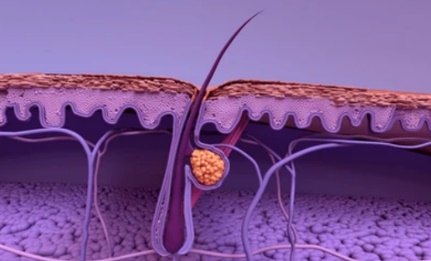As a dedicated research services provider, we specialize in delivering comprehensive, one-stop preclinical solutions for rare skin disease drug and therapy development. From disease model development to groundbreaking therapeutic research, we support your project with tailored strategies and cutting-edge expertise, ensuring the highest quality and efficiency in advancing your innovations to success.
Introduction to Rare Skin Diseases
Rare skin diseases, including genodermatoses, represent a large group of inherited skin disorders with clinically heterogeneous manifestations affecting the skin and other organs. Recent research highlights the genetic and molecular underpinnings of these conditions, providing new insights into potential therapeutic targets. As understanding deepens, the importance of interdisciplinary collaboration in addressing these complex disorders is increasingly emphasized in the scientific community.

Fig.1 A flow chart of ex-vivo epidermal sheet graft gene therapy. (Ain, Q. U.,
et al., 2021)
Therapeutics Development for Rare Skin Diseases
In recent years, therapeutic development for rare skin diseases has increasingly focused on precision medicine, gene therapies, and localized treatments to minimize systemic side effects. These approaches aim to address the underlying genetic and molecular causes of the diseases, such as using gene editing to correct mutations or localized drug delivery systems targeting affected tissues.
Table.1 Molecular Therapeutics for Skin Diseases (Uitto, J., 2021)
| Therapy |
Target Disease |
Target |
Development Stage |
| Gene Therapy (ex vivo) |
Junctional Epidermolysis Bullosa (JEB) |
LAMB3 gene (β3 subunit of laminin 332) |
Complete |
| Small Interfering RNA (siRNA) Therapy |
Pachyonychia Congenita (PC) |
KRT6A gene (keratin mutation) |
Phase I |
| Allogeneic Fibroblast Therapy |
Recessive Dystrophic Epidermolysis Bullosa (RDEB) |
COL7A1 gene (Type VII Collagen) |
Phase I |
| Induced Pluripotent Stem Cells (iPSC) Therapy |
RDEB and other genetic skin disorders |
Correction of disease-causing genes |
Preclinical stage |
| Protein Replacement Therapy |
RDEB |
Type VII Collagen |
Preclinical stage |
Disclaimer: Protheragen focuses on providing preclinical research services. This table is for information exchange purposes only. This table is not a treatment plan recommendation. For guidance on treatment options, please visit a regular hospital.
Diseases Model Development for Rare Skin Diseases
The development of disease models for rare skin diseases is crucial for understanding their pathophysiology and testing potential therapies. These models are broadly categorized into 2D cell models, 3D models, and animal models, each offering unique advantages in simulating the complexity of skin diseases.
2D Cell Models
2D cell models are essential for studying rare skin diseases, offering insights into cellular responses, genetic mutations, and drug effects. While they are simple, cost-effective, and suitable for high-throughput screening, they lack the ability to replicate the skin's three-dimensional structure and complex cellular interactions.
3D Models
3D skin models provide a biologically relevant platform by mimicking the skin's multi-layered architecture and cellular interactions. They are particularly useful for studying diseases like epidermolysis bullosa and testing advanced therapies, including gene editing and localized drug delivery.
Animal Models
Animal models are crucial for studying rare skin diseases at the whole-organism level, allowing insights into disease progression and therapeutic efficacy. Genetically modified animals, like mice modeling epidermolysis bullosa, help test gene therapies and treatments.
Our Services
We specialize in supporting the research and development of therapies for various types of rare skin diseases. Each condition involves unique genetic and pathological features, and our team's extensive expertise enables us to tackle these complexities. We offer customized solutions to drive the advancement of effective treatments, addressing the distinct challenges of these skin disorders.
Types of Rare Kidney Diseases
At our company, we provide specialized services to advance therapies for rare skin diseases. With expert teams and innovative technologies, we drive progress to overcome the unique challenges posed by these complex conditions.
Our company is dedicated to providing comprehensive, one-stop preclinical development services for rare skin diseases, covering everything from disease model development to innovative therapy research, along with specialized support in drug metabolism and pharmacokinetics services and drug safety evaluation. If you are interested in our services, please don't hesitate to contact us.
References
- Ain, Q. U., et al. "Gene Delivery to the Skin - How Far Have We Come?" Trends Biotechnol 39.5 (2021): 474-87.
- Jayarajan, V., et al. "Ex Vivo Gene Modification Therapy for Genetic Skin Diseases-Recent Advances in Gene Modification Technologies and Delivery." Exp Dermatol 30.7 (2021): 887-96.
- Uitto, J. "Molecular Therapeutics for Heritable Skin Diseases." J Invest Dermatol 132.E1 (2012): E29-34.
All of our services and products are intended for preclinical research use
only and cannot be used to diagnose, treat or manage patients.



 Fig.1 A flow chart of ex-vivo epidermal sheet graft gene therapy. (Ain, Q. U., et al., 2021)
Fig.1 A flow chart of ex-vivo epidermal sheet graft gene therapy. (Ain, Q. U., et al., 2021)



